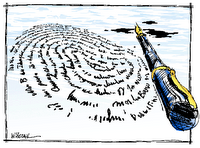
Every so often I run across a book or journal article that, in my opinion, resonates with considerable clarity re: something important regarding human intelligence and or understanding learning and or learning disabilities. I'm not sure if these readings, as viewed by others, would be accorded similar value, or if the readings just hit me at a time when I'm trying to
"connect the dots" across the diverse literature that I skim on a routine basis.
I just finished skimming one such article. The article is by
David Geary in
Developmental Neuropsychology (2007, vol 32[1], p. 471-519;
click here to view). The title of the article is "
An evolutionary perspective on learning disabilities in mathematics." I try to read anything that David Geary writes as, IMHO, he is one of the top notch intelligence/cognitive scholars of our times, particularly as his research relates to helping us understand an important aspect of school learning--
mathematics.
I plan (hope) to make a number of posts as I distill the essence of what he has written. The real beauty of this article is that it is a grand synthesis article that puts, in one place, his current synthesis of contemporary research on the development of mathematics and possible causes of math learning disabilities.
At this time I'm just alerting my readers to the article and making it available for viewing. Although some of the evolutionary material may be a bit difficult to digest, and does not have direct application to applied intelligence testing and interventions, the remainder of the article is packed with useful summary statements regarding the potential cognitive mechanisms, underlying neuroanatomy, etc. of mathematical learning.
More to come. But in the meantime, please read and digest on your own pace. I urge readers to take the time to become familiar with this article, as well as other research published by David Geary (a select list is below).
- Fink, B., Brookes, H., Neave, N., Manning, J. T., & Geary, D. C. (2006). Second to fourth digit ratio and numerical competence in children. Brain and Cognition, 61(2), 211-218.
- Geary, D. C. (2001). The development of intelligence, by M. Anderson. Contemporary Psychology APA Review of Books, 46(1), 23-25.
- Geary, D. C. (1999). Evolution and developmental sex differences. Current Directions in Psychological Science, 8(4), 115-120.
- Geary, D. C. (2007). An evolutionary perspective on learning disability in mathematics. Developmental Neuropsychology, 32(1), 471-519.
- Geary, D. C. (2006). Gender differences in mathematics: An integrative psychological approach, by A.M. Gallagher, J.C. Kaufman. British Journal of Educational Studies, 54(2), 245-246.
- Geary, D. C. (1993). Mathematical disabilities: Cognitive, neuropsychological, and genetic components. Psychological Bulletin, 114(2), 345-362.
- Geary, D. C. (2004). Mathematics and learning disabilities. Journal of Learning Disabilities, 37(1), 4-15.
- Geary, D. C. (2005). Role of cognitive theory in the study of learning disability in mathematics. Journal of Learning Disabilities, 38(4), 305-307.
- Geary, D. C., Hamson, C. O., & Hoard, M. K. (2000). Numerical and arithmetical cognition: A longitudinal study of process and concept deficits in children with learning disability. Journal of Experimental Child Psychology, 77(3), 236-263.
- Geary, D. C., & Hoard, M. K. (2003). Learning disabilities in basic mathematics - Deficits in memory and cognition. J. M. RoyerMathematical Cognition (pp. 93-115). PO Box 4967/Greenwich/CT 06831/USA: Information Age Publishing.
- Geary, D. C., Hoard, M. K., ByrdCraven, J., Nugent, L., & Numtee, C. (2007). Cognitive mechanisms underlying achievement deficits in children with mathematical learning disability. Child Development, 78(4), 1343-1359.
- Geary, D. C., Hoard, M. K., & Hamson, C. O. (1999). Numerical and arithmetical cognition: Patterns of functions and deficits in children at risk for a mathematical disability. Journal of Experimental Child Psychology, 74(3), 213-239.
- Geary, D. C., & Huffman, K. J. (2002). Brain and cognitive evolution: Forms of modularity and functions of mind. Psychological Bulletin, 128(5), 667-698.
- Geary, D. C., Liu, F., Chen, G. P., Saults, S. J., & Hoard, M. K. (1999). Contributions of computational fluency to cross-national differences in arithmetical reasoning abilities. Journal of Educational Psychology, 91(4), 716-719.
- Geary, D. C., Saults, S. J., Liu, F., & Hoard, M. K. (2000). Sex differences in spatial cognition, computational fluency, and arithmetical reasoning. Journal of Experimental Child Psychology, 77(4), 337-353.
- Geary, D. C., & Widaman, K. F. (1992). Numerical cognition: On the convergence of componential and psychometric models. Intelligence, 16, 47-80.
- Geary, D. C., Liu, F., Chen, G.-P., Saults, S. J., & Hoard, M. K. (1999). Contributions of Computational Fluency to Cross-National Differences in Arithmetical Reasoning Abilities. Journal of Educational Psychology, 91(4), 716-719.
- Geary, D. C., & Widaman, K. F. (1992). Numerical cognition: On the convergence of componential and psychometric models. Intelligence, 16(1), 47-80.
- Trull, T. J., & Geary, D. C. (1997). Comparison of the big-five factor structure across samples of Chinese and American adults. Journal of Personality Assessment, 69(2), 324-341.
- Widaman, K. F., Gibbs, K. W., & Geary, D. C. (1987). Structure of adaptive behavior: I. Replication across fourteen samples of nonprofoundly mentally retarded people. American Journal of Mental Deficiency, 91(4), 348-360.



 All the news thats fit for IQ's Corner readers:
All the news thats fit for IQ's Corner readers:




